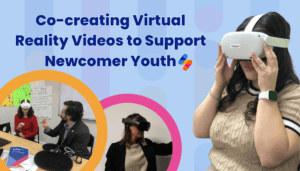As resettlement service providers, we’re quick to notice when something is working well and when it isn’t. That’s because a key priority is serving clients as smoothly as possible. However, when faced with the challenge of gauging the effectiveness of a program, advocating for funding, or implementing a new intervention, discovering what works best takes extensive research and trial and error, both of which require time and bandwidth that are in short supply. That’s where evidence summaries come in. They can serve as invaluable readymade tools to inform the design and implementation of programs that positively impact newcomers’ lives.
What are evidence summaries?
Evidence summaries are short documents that consolidate the literature and state of evidence related to outcomes or interventions from primary and secondary research studies. Primary research studies are those in which the author of the article is the principal researcher who conducted the study (e.g., interviews, surveys, and analyses of quantitative data). Secondary studies are those in which the author analyzes primary studies by other authors (e.g., systematic reviews and literature reviews).
Evidence summaries are often driven by a research question and use specific search criteria from studies that are designed to yield comprehensive results. For example, an evidence summary may be driven by the question, “What works to improve completion of secondary education for newcomer youth?” In this case, specific key terms will be used, such as “high school completion,” or “secondary education completion” to search for the most appropriate research articles in peer-reviewed journals or other articles from reputable sources. You can learn more about the evidence selection process here.
In short, evidence summaries present mountains of quality research in an easily digestible format to support evidence-based services to newcomers.
How Refugee Service Providers Can Use Evidence Summaries
While there are many ways that evidence summaries can be utilized, here are some more common and direct ways you can use them as a refugee service provider:
1. Advocacy and Funding
A great way to use evidence summaries is to share their key takeaways with policymakers, funders, and other stakeholders to demonstrate the benefits of using evidence-based interventions in refugee services.
Consider this scenario: Faraji is seeking additional funding from the Office of Refugee Resettlement (ORR) to expand an educational program. He might use the evidence summary on creating culturally responsive learning environments from Switchboard to provide concrete data on evidence-based programs that are similar to his program’s strategy with the population he is serving. If the quality of studies and the evidence are both significant, his intervention is backed by “strong” evidence of effectiveness. This evidence summary also provides Faraji with key terms from across studies, offering a shared language with which to refer to his own practices.
2. Program Design and Effectiveness
Evidence summaries can help refugee service providers make informed decisions about which interventions or approaches to use when designing new programs. Through a review of relevant evidence summaries, you can identify evidence-based interventions shown to be effective.
For example, such summaries can highlight gaps in service provision—such as the lack of mental health support for refugees—and recommend interventions to address those gaps.
Consider this scenario: Jasmine, a case worker, notices her clients are not benefiting from the mental health services her agency currently provides. She wonders what strategies and services other organizations provide that have been shown to benefit newcomer clients. Jasmine reads the evidence summary What works to improve mental health of refugee children and adults? and discovers that culturally responsive programs seem to work the best. Jasmine works with her supervisory team to redesign the mental health services they provide to ensure they are culturally appropriate for the clients they are serving.
3. Staff Training
Integrate the latest research and evidence on relevant interventions in staff training opportunities. By sharing the latest evidence-based information and best practices, staff members are better equipped to provide the most effective and appropriate services.
Consider this scenario: Imani, the executive director of a resettlement center, is struggling to train her staff on how to offer services that can help increase clients’ financial capability. She reads the Switchboard evidence summary What works to improve people’s financial capability? and learns that the findings of various studies suggest that service bundling is more effective than any single intervention effort on its own. Service bundling occurs when a client receives multiple services from the same organization that all work toward achieving the same outcome. For example, to increase financial capability, an organization may offer financial literacy training and cash assistance. Imani can now develop a training program that incorporates service bundling as a key tenet. After training staff to bundle services, the resettlement center is likely to observe more positive client outcomes.
Evidence Summaries Inform Evidence-Based Practice
Resettlement practitioners can utilize the data and evidence from evidence summaries to ensure programs are aligned with strong evidence-based practice (EBP).
An EBP is a decision-making process that integrates the best available evidence, the practitioner’s expertise, and information on the client’s characteristics, culture, and preferences.
EBP offers numerous benefits:
- Enhances the quality, effectiveness, and efficiency of interventions
- Reduces the likelihood of harm from interventions
- Leads to the development of new knowledge
- Facilitates the practitioner’s decision-making process
- Fosters lifelong learning and critical thinking among practitioners
- Promotes positive outcomes by emphasizing shared decision-making between practitioners and clients
Evidence summaries can inform your EBP by providing you with the data and evidence required to make evidence-backed decisions.
Explore Switchboard’s Evidence Summaries
If you’re working on advocacy, program design, evaluation, or staff training possibilities, explore the extensive database of evidence summaries available in the Switchboard library.
Here are some recent and popular evidence summaries produced by Switchboard:
What works to support LGBTQ refugees?
This evidence summary describes the state of available evidence regarding practices and programs for LGBTQ refugees. This is especially important because members of this community often lack the support networks that other refugees rely on.
What works to improve mental health of refugee children and adults?
This evidence summary highlights the numerous interventions that are effective in improving the mental health of child and adult refugees. Cultural adaptations and digital technologies are promising.
What are the impacts of case management on refugees?
This evidence summary assesses the state of available evidence regarding the impacts of case management on outcomes such as self-sufficiency, social support, employment, education, health, mental health, and service access.
What works to prevent and respond to intimate partner violence among refugees?
This evidence summary assesses the state of available evidence regarding interventions to prevent or respond to intimate partner violence among resettled refugees.
What works to build welcoming and inclusive communities?
This evidence summary assesses the evidence surrounding the effectiveness of available interventions for building inclusive communities, including contact-based interventions, bystander interventions, and youth-focused interventions.
What works to reduce burnout and vicarious trauma among refugee service providers?
This evidence summary highlights strong evidence for a variety of strategies to reduce vicarious trauma, secondary traumatic stress, compassion fatigue, and burnout among helping professionals. Effective strategies encompass both organizational and self-care interventions.
Other resources that include evidence summaries are the University of Manchester’s Humanitarian and Conflict Response Institute and the Migration Policy Institute, among others.










